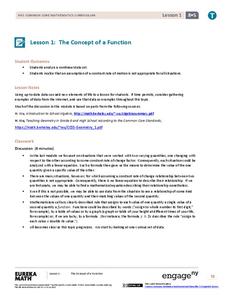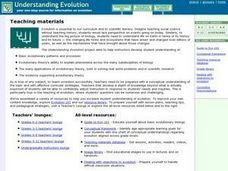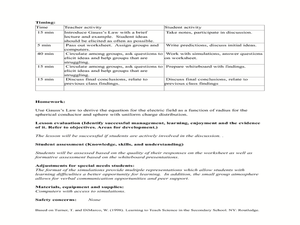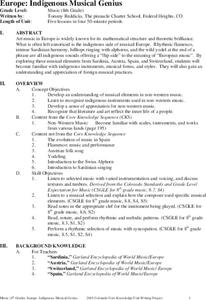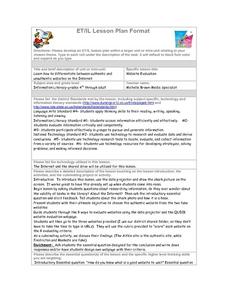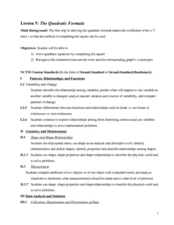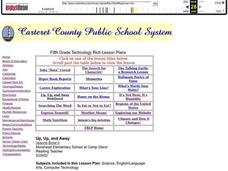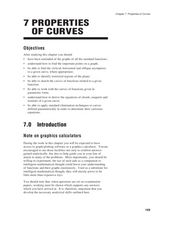EngageNY
The Concept of a Function
Explore functions with non-constant rates of change. The first installment of a 12-part module teaches young mathematicians about the concept of a function. They investigate instances where functions do not have a constant rate of change.
Curated OER
Making Cladograms
High schoolers construct cladograms (evolutionary trees), showing how shared derived characters can be used to reveal degrees of relationship. They interpret and analyze cladograms, and determine where unclassified vertebrates would fit...
Curated OER
#3 Differential Calculus
Students create models of the Mean Value Theorem. In this Mean Value lesson, students use their knowledge of derivatives and exponential functions to explore the Mean Value Theorem. They illustrate the meaning of the throrem,...
Curated OER
Modeling Natural Disaster with Mathematical Functions
Ninth graders investigate the functional relationship of different environmental phenomena. In this math lesson, 9th graders create models of various natural disasters. They use logarithmic and exponential functions to interpret...
Curated OER
Finding Our Place in Time
Students utilize interviewing skills of an historian to research the time period of the 1970's. They use prior knowledge of the 1960's to explain the mood of the country in the 1970's.
Curated OER
Australian Mammals: Evolutionary Development as a Result of Geographic Isolation
Students comprehend the difference between monotremes, marsupials, and placental mammals. They are able to compare and contrast these organisms (Australian mammals) with other mammals. Students are able to identify Australian mammals.
Curated OER
Fossil Fuels (Part II), The Geology of Oil: Topographic Mapping, Crustal Deformation, Rock Porosity, and Environmental Pollution
Students review an interpretation of geologic history and relate it to the formation of oil deposits. They explore and explain factors controlling the porosity and permeability of sediments and sedimentary rocks. Pupils also interpret...
Curated OER
Exponential Decay
Students study exponential decay and its application to radiocarbon dating. In this exponential decay lesson, students use candy to model the time it takes for something to decay. Students also graph the data they collect and...
Curated OER
Difference of Equations
In this difference of equations worksheet, students solve and complete 49 various types of problems. First, they obtain the solution of any linear homogeneous second order difference equation. Then, students apply the method of solution...
Curated OER
Comprehension of Word Problems
Third graders explore math functions by completing a worksheet in class. In this word problem solving lesson plan, 3rd graders read a book titled Counting on Frank by Rod Clement and utilize the information in the story to answer study...
Curated OER
Gauss' Law
Learners derive the equation of Gauss's law. In this physics lesson, students investigate the factors affecting the strength of the electric field. They perform simulation on Gauss's law.
EngageNY
Base 10 and Scientific Notation
Use a resource on which you can base your lesson on base 10 and scientific notation. The second installment of a 35-part module presents scholars with a review of scientific notation. After getting comfortable with scientific...
Curated OER
We Approach the Lenten Journey
After reading the story of Zacchaeus and Jesus as depicted in the Bible, young learners design bracelets of beads representing their lenten journeys in an engaging and ongoing hands-on learning activity.
Curated OER
Secant Line Approximation of the Tangent Line
Students perform operation with secant and tangent lines. In this calculus lesson, students find the derivative and relate it to the slope of a line. They differentiate between secant and tangent as they intersect a circle, using Cabri.
Curated OER
Shel Silverstein Poetry Math
Fifth graders explore the connection between poetry and math by reading poems that involve numbers. In this Shel Silverstein poetry math lesson, 5th graders listen to 5 poems read aloud and discuss how math was used in the...
Curated OER
Europe: Indigenous Musical Genius
Students are introduced to several forms of indigenous European music. Students become familiar with instruments, musical and forms and styles from Spain, Sardinia, Austria and Switzerland. Students recreate selected rhythms and styles.
Curated OER
Website Evaluation
Students examine how to differentiate between authentic and unauthentic websites on the Internet. They view and discuss a photo of a shark that is a hoax, then discuss the eight ways to evaluate websites. Students then evaluate three...
Curated OER
The Quadratic Formula
Students derive the quadratic formula. In this algebra lesson, students use the quadratic formula to solve equations and identify the roots of a quadratic equation. They graph their parabola and analyze it.
Curated OER
Up, Up, and Away
Fifth graders participate in a WebQuest that introduces them to a study on clouds and how they relate to weather systems.
Curated OER
Winter
Young scholars examine how animals adapt to the harsh New England winter. They discuss articles they have read on the subject.
Curated OER
Diffusion & Osmosis with Data Analysis
Students explore principles governing diffusion and osmosis. Students perform a dialysis tubing experiment. They obtain core samples of potato in varying concentrations of sugar-water to measure water potential of the potato cells....
Curated OER
Roots
Students are introduced to Latin and Greek roots, prefixes, and suffixes. They are given a lesson on ten root words that students identify the correct meaning of the words. Students design cards that are divided into four parts.
Curated OER
Properties of Curves
In this Calculus instructional activity, students use a graphing calculator to boost their understanding of functions and their graphs as they examine the properties of curves. The forty-two page instructional activity contains one...
Curated OER
Two Column Logic Proofs
Students complete two column proofs. In this geometry lesson,students derive the reasons their answers are correct using logic. They write the proof step by step using two columns.
